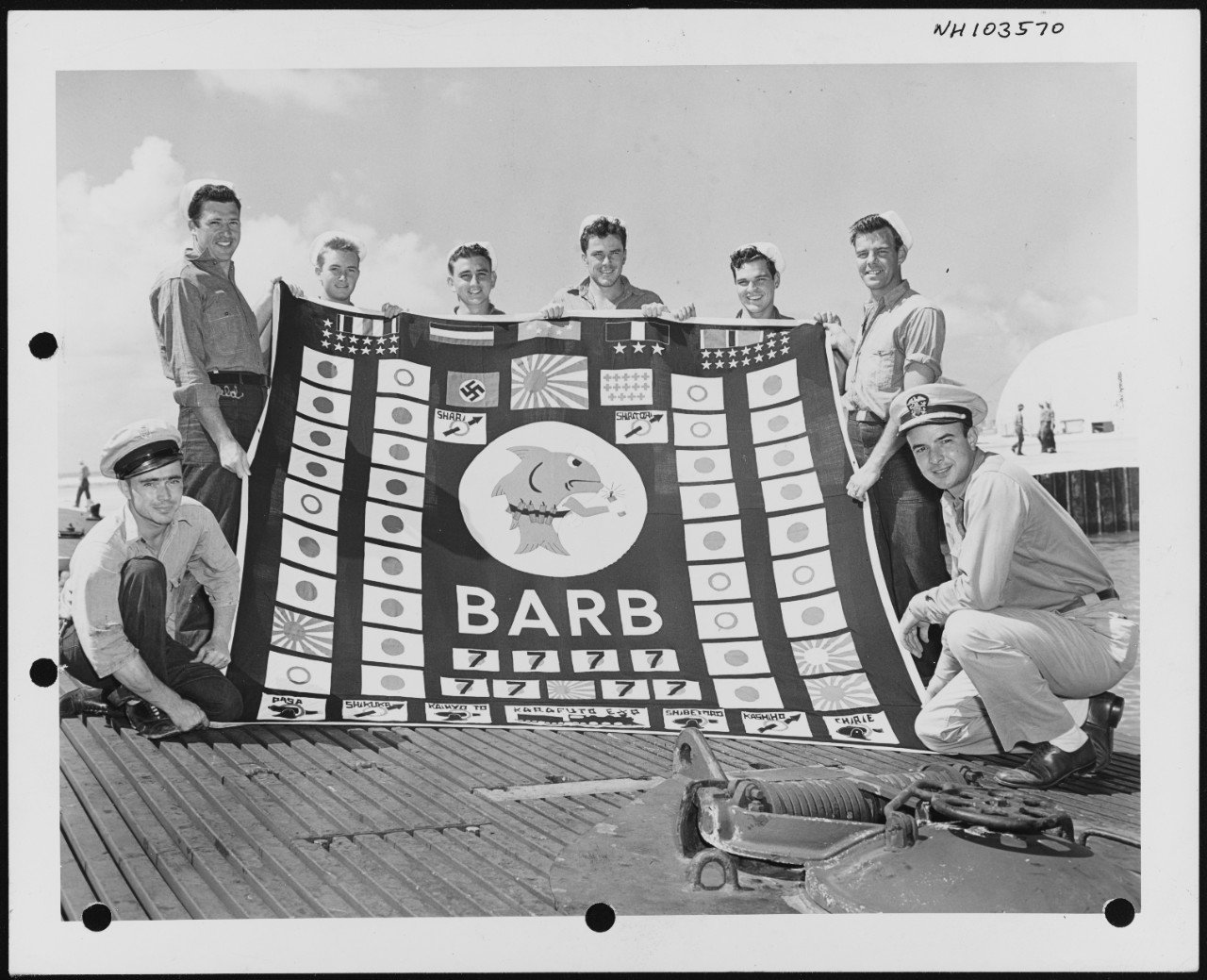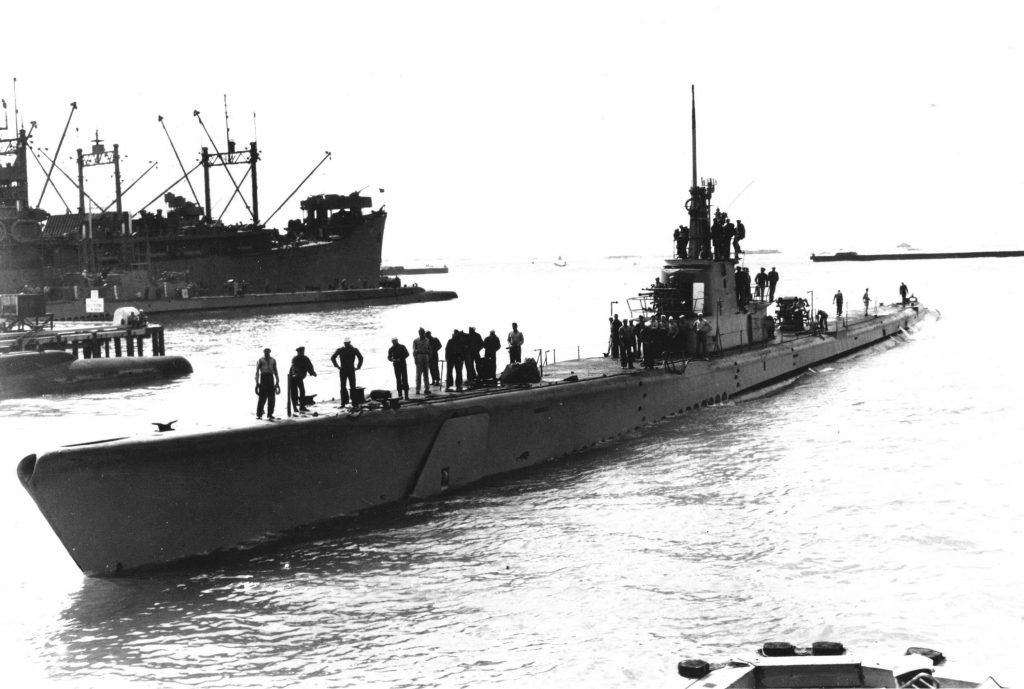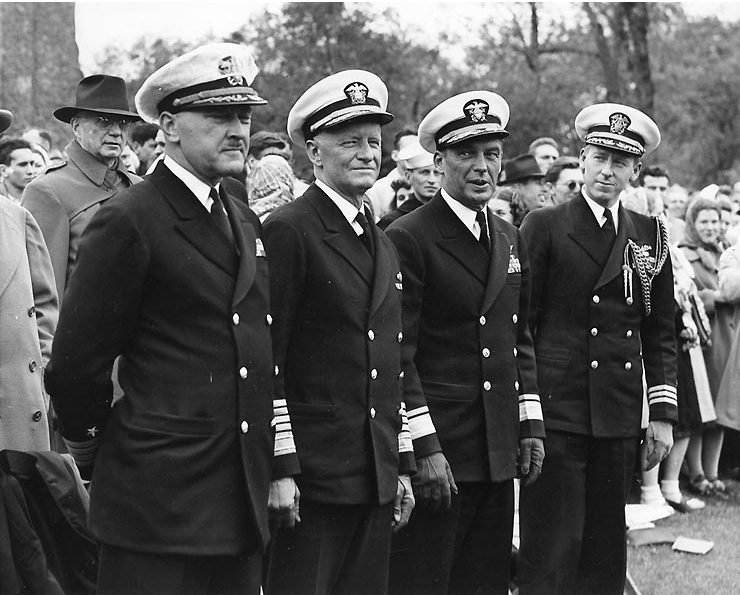Sabotage By Boy Scouts: The Only Submarine to Sink A Freight Train

Members of the submarine’s demolition squad pose with her battle flag at the conclusion of her 12th war patrol at Pearl Harbor, August 1945. During the night of July 22-23, 1945 these men went ashore at Karafuto, Japan, and planted an explosive charge that subsequently wrecked a train. This raid is represented by the train symbol in the middle bottom of the battle flag. Photo courtesy of the U.S. Navy/Naval History and Heritage Command.
Lt. Cmdr. Eugene “Gene” Fluckey had four war patrols under his belt, a Medal of Honor, and three Navy Cross medals. The submarine commander wreaked havoc in the Pacific, destroying scores of Japanese naval convoys using the popular German Navy “wolfpack” tactic. He expected the very best from his crew, reminding them of his motto: “We don’t have problems, just solutions.”
As the commander of the Gato-class USS Barb, “Lucky Fluckey” innovated submarine warfare. His sub patrolled the ocean while surface-cruising, only submerging to escape from danger. He targeted Japanese cruisers at night and even used his sub as a battering ram to sink an enemy ship after he ran out of torpedoes. He made history as the only American submarine skipper to fire rocket missiles on coastal Japanese batteries and factories — and that’s not even his most notorious action.
While patrolling the Japanese coast, he witnessed from his periscope Japanese trains bringing supplies, weapons, and war materials to Karafuto, an island located in the north. Chief of the Boat Paul Golden “Swish” Saunders, a veteran of all 12 of the USS Barb’s war patrols, sprawled a topographic map across a table showing Japanese rail lines. They devised a plan to destroy it.

Engineman Third Class Billy Hatfield suggested jerry-rigging demolition charges between the ties on the railroad with a micro-switch. As a boy, he used the technique to crack open nut shells as the train passed over them — only this time the train connected the killswitch to detonate the explosives.
Fluckey called for volunteers, and every sailor on board raised his hand. Only eight met his requirements for the mission, including Saunders and Hatfield, who was assigned to lead the commandos ashore. The volunteers had to be unmarried, have a mix of experience, and at least half had to be Boy Scouts because, as Fluckey reasoned as a former Scout himself, Boy Scouts always know what to do in case of an emergency.
On July 23, 1945, Fluckey parked his submarine 950 yards offshore of the southern half of Sakhalin Island. Just after midnight, the saboteurs prepared their gear to set out for the Japanese mainland in their rubber boats.
“Boys, if you get stuck, head for Siberia, 130 miles north,” Fluckey said, as told to the New York Times. “Following the mountain ranges. Good luck.”

The eight commandos were among the first Americans into Japan, and the footprints and paw prints that indicated a patrol area piqued their concern. Two men guarded the boats to ensure a quick exfiltration once the task was complete. The other six snuck through the brush, tripped over a drainage ditch, and crossed a highway. They quietly slipped past a Japanese sentry tower where the lookout was fast asleep. As they were fixing the explosives to the tracks, Hatfield felt the metal rattle and vibrate, indicating an oncoming train. The commandos dove into some nearby brush for concealment and waited for the train to disappear into the distance. Failure of the mission wasn’t an option for this crew.
Hatfield emerged from his hiding spot and crouched over the explosives once more. He cinched them down between the railroad ties before giving the signal to leave. They returned the way they came and paddled through the surf to reach the surfaced submarine just as a roaring sound of the train’s horn came into earshot. Moments later, the railroad tracks ceased to exist, the explosion hurled the train carriages 200 feet into the air, and a massive fireball could be seen from the submarine’s periscope.
The submarine and the commandos vanished beneath the waves. The USS Barb became the first and only submarine to “sink” a freight train, and Fluckey earned his fourth and final Navy Cross. Fluckey later wrote in his memoir, “No one who ever served under my command was awarded the Purple Heart for being wounded or killed, and all of us brought our Barb back safe and sound.”

Matt Fratus is a history staff writer for Coffee or Die. He prides himself on uncovering the most fascinating tales of history by sharing them through any means of engaging storytelling. He writes for his micro-blog @LateNightHistory on Instagram, where he shares the story behind the image. He is also the host of the Late Night History podcast. When not writing about history, Matt enjoys volunteering for One More Wave and rooting for Boston sports teams.
BRCC and Bad Moon Print Press team up for an exclusive, limited-edition T-shirt design!
BRCC partners with Team Room Design for an exclusive T-shirt release!
Thirty Seconds Out has partnered with BRCC for an exclusive shirt design invoking the God of Winter.
Lucas O'Hara of Grizzly Forge has teamed up with BRCC for a badass, exclusive Shirt Club T-shirt design featuring his most popular knife and tiomahawk.
Coffee or Die sits down with one of the graphic designers behind Black Rifle Coffee's signature look and vibe.
Biden will award the Medal of Honor to a Vietnam War Army helicopter pilot who risked his life to save a reconnaissance team from almost certain death.
Ever wonder how much Jack Mandaville would f*ck sh*t up if he went back in time? The American Revolution didn't even see him coming.
A nearly 200-year-old West Point time capsule that at first appeared to yield little more than dust contains hidden treasure, the US Military Academy said.












